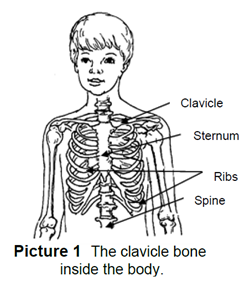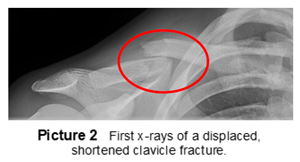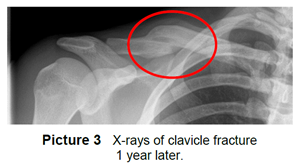Clavicle Fracture


Your child has two clavicles (collarbones). Each clavicle extends from the top of the sternum (breastbone) to the shoulders (Picture 1).
A clavicle fracture is common in children after a collision or fall onto the shoulder. Most clavicle fractures that occur in children can be treated without surgery.
Treatment

Depending on the type, place and severity of the fracture, the medical practitioner (doctor, nurse practitioner, or physician assistant) will decide the proper treatment.
Clavicle fractures do not need to line up perfectly to heal properly. On many fractures, the ends overlap (are shortened) and/or the pieces are displaced (not touching) (Picture 2). A ball of bone (callus) will form around the fracture to heal it. That ball of bone will smooth out (remodel) over time (Picture 3). Please ask your child’s provider for further information on fracture healing and bone remodeling.

Your child may always have a bump where the fracture was, but this should not affect their ability to participate in all activities. Most clavicle fractures do not need surgery. If the clavicle can be treated without surgery, the practitioner may use a clavicle strap or a sling (with or without a chest strap), or both. This helps protect the fracture and provides comfort.
The strap helps keep the two parts of the bone lined up to reduce painful movements of the parts of the bone. Your child may need it for 3 or more weeks.
When to Call the Medical Practitioner
For the first 24 to 48 hours, your child may have some swelling in the arm. Swelling happens if the arm hangs at the side too long. Gravity pulls fluid into the hand and fingers. This leads to swelling, discomfort, numbness, tingling, coolness and color changes.
If the medical practitioner does not limit your child’s activity, the child should do the following movements 5 to 6 times a day. The movements prevent swelling and stiffness and help circulation.
Elbow:
- Straighten and bend the elbow 10 to 15 times.
Wrist:
- Wave the hand up and down 10 to 15 times.
- Make 10 circles starting to the right, then 10 circles starting to the left.
Fingers:
- Wiggle fingers for 20 seconds.
- Make a fist, then spread fingers wide apart; repeat 10 times.
If your child’s symptoms do not improve using the arm movements, contact their practitioner. The practitioner may need to see your child to evaluate them.
If Your Child Wears a Clavicle Strap
- Tighten the strap so that the shoulders are pulled back and down (Pictures 4 and 5). Check the strap several times during the first day to be sure the closures are fastened securely.
- Starting on the second day, tighten the straps every other day for 7 to 10 days. Do this because the straps will stretch. Make sure your child's shoulders are pulled back when you tighten the straps
- Depending on the severity of the fracture you may be instructed not to remove the strap. If that is the case, your child should sponge bathe until allowed to remove the strap.
- Your practitioner will tell you when you may remove the strap for bathing. Put the clavicle strap back on right after bathing.


Clothing
- Your child should wear clothing that closes in the front or back - not pullover shirts.
- When helping your child get dressed, put the arm with the broken collar bone into the sleeve first. When helping them undress, take the good arm out of the sleeve first.
Skin Care
- Look for signs of skin irritation from the strap every day.
- If there is redness and pain or the skin becomes raw, call your child’s clinic or practitioner.
Activity
- Your child should not play any sports and should not lift or pull anything with the injured arm.
- Your child should be lifted by the chest or waist only, not by the arms and not under the arms.
- When holding your child's hand, hold the hand on the uninjured side.
Follow-up Appointments
Make an appointment with your child's practitioner or clinic now, for 1 to 2 weeks after the injury.
If your child needs to see an Orthopedic practitioner, call the Orthopedic clinic in Columbus at (614) 722-5175 or in Toledo at (419) 251-2061.
If you have any questions, be sure to ask your medical provider.
HH-I-65 ©1996, Revised 2020, Nationwide Children’s Hospital

